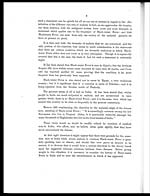Medicine - Institutions > Army health reports and medical documents > Scientific memoirs by officers of the Medical and Sanitary Departments of the Government of India > Number 35 - Black-water fever > Part I - Introductory
(21) Page 9
Download files
Individual page:
Thumbnail gallery: Grid view | List view

9
Maclean (43) in his lectures upon the Diseases of Tropical Climates (1886) states,
with reference to the urine in certain cases of remittent fever, that " In some
cases recorded by me there was profuse secretion of bloody urine, which last-
ed until convalescence set in." But Powell (26) was the first actually to recog-
nise the disease, when he recorded the occurrence of a number of cases in Cachar.
A little later other cases were reported from Sylhet, the Darjeeling Terai,
Cachar, and the Duars. Stephens and Christophers, who described four cases
from the Duars, also note in their report to the Royal Society that cases had been
met with in other parts of India, including Hazaribagh, Meerut, Roorkee, and
Secunderabad, while the disease is common among the Europeans in the Jey-
pore Hills. They also mention that cases of the disease have been seen from time
to time in the hospitals of Calcutta and Madras, though these may have originated
in other places.
Since then Christie (32) has recorded three cases from Canara in the Bom-
bay Presidency, and DeCruz (33) a further number of cases among both Europeans
and natives in the Jeypore district.
Nor are these the only places in which Black-water Fever may occur in India.
In our list of cases given in the present memoir we are able to record one
in a European from Purulia in Chota Nagpore; and Colonel C. J. Bamber, I.M.S.,
has drawn our attention to the death of a European officer from Black-water
Fever in the Lower Godavery district, a reputedly malarious part of Southern
India. Doctor Gopal Chatterjee has also told us of two cases in Bengalis living
near Calcutta, where he states there are some very malarious villages. The
family in which both cases occurred had for some time been suffering from malaria,
and he had on several occasions found them to have malarial parasites in their
blood. Doctor Bramacheri has given us particulars of a case arising in a native
of the Burdwan district.
These represent, we feel sure, only a few of the districts in which the disease
may be occasionally met with. Many other likely areas probably have no Euro-
pean residents; but in others where Europeans and educated natives reside we
suspect that careful enquiry would show the disease to exist.
A common belief, that a disease having such a striking symptomatology as
Black-water Fever can scarcely be overlooked, is not borne out by experience; it is
only too frequently entirely unrecognised or confused with other diseases, when it
occurs in districts in which it has not previously been diagnosed. As a rule where
Black-water Fever occurs, men are for the most part living remote from civilization,
and the disease being a sudden one and soon over a case except under special
circumstances is often not seen by any medical man. Again in all such
227 H. D.
Set display mode to: Large image | Zoom image | Transcription
Images and transcriptions on this page, including medium image downloads, may be used under the Creative Commons Attribution 4.0 International Licence unless otherwise stated. ![]()
| Permanent URL | https://digital.nls.uk/75060299 |
|---|
| Shelfmark | IP/QB.10 |
|---|---|
| Additional NLS resources: | |




